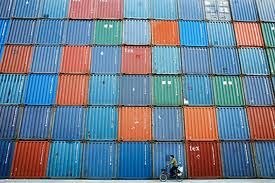
Index linked contracts are a response to the failure of traditional fixed rate contracting…Persistent freight rate volatility is forcing container shipping to consider alternative forms of shipper-carrier contracting arrangements that enable the contract rate to vary relative to an external index. Index-linked contracts are a response to the failure of traditional fixed-rate forms of contracting to provide the necessary space, volume and price protections.
Freight rate volatility will continue for the foreseeable future…
Container shipping rates have become increasingly volatile in recent years. Volatility will continue to be a feature of container shipping, given the uncertain economic outlook
and changing characteristics of the industry.
Wide disparities between spot and contract rates have caused contract default…
This volatility has caused wide disparities to develop between short term “spot rates” and longer term “contract rates”, triggering contract default as either party has been tempted by more favourable rates in the spot market. Contract default has added to supply chain costs and
carrier losses…
As a result, cargo owners have experienced progressively unpredictable supply chain costs and risks to surety of capacity availability. Such supply chain disruptions can be very costly to importers and exporters in expedited freight transport costs or lost sales. Meanwhile, carriers have experienced unsustainable financial losses and shippercarrier relations have come under increasing strain.
Index-linked contracts reduce this disparity, so addressing the drivers of default…
Enabling the contract rate to vary relative to an external index serves to reduce any possible divergence between contract and spot rates, so addressing the drivers of contract default.
They also reduce shipper tender costs & carrier cost of sale…
In order for both parties to benefit, index-linked contracts work best over contract periods of more than one year. Enabling longer term contracts and the decoupling of price from negotiations (as this is determined by the index), shippers can reduce their procurement process costs and carriers their cost of sale.
The chosen index should follow the spot market…It is important that the selected index follows the spot market (not contract rates or a combination of the two). Otherwise the index-linked contract will fail in its mission to reduce the differential between contract and spot market rates and the resultant risk of contract default. There are two principal models of index-linked contracts….
Two models of index-linked contracts have emerged: Time Lag and Real Time contracts. The former adjust the future contract rate based on a past change in the index; whereas with the real time model, contract rate adjustments are synchronised with changes in the index. The vast majority of index-linked contracts in operation today are based on the time lag model.
Real time index-linked contracts combined with hedging have optimal potential…
Real time contracts are less prevalent but are expected to become more widespread with the parallel use of container freight derivatives to hedge risk exposure to freight rate volatility. In combination these two instruments enable delivery of optimal space/volume guarantees as well as freight rate certainty.
Adoption of index-linked contracts is growing rapidly…
Industry wide adoption of index-linked contracts is gaining momentum. In May 2012 the Federal Maritime Commission (FMC) confirmed that 61 index-linked contracts covering US trades had been filed with the organisation. Drewry estimates that around 50 index-linked contracts have been signed on the Asia-Europe trade.
Several major shipping lines are pioneering the development of index-linked contracts, led by Maersk and CMA CGM and many shippers and forwarders are exploring options to adopt this new form of contracting.
By 2020 most container shipping contracts will be index-linked
Index linked contracts are common place in other forms of shipping and are a standard feature of highly commoditised markets. It is quite conceivable that by 2020 the vast majority of containerised ocean freight will be transacted on the basis of index-linked contracts.
Contracts will be negotiated on the basis of discounts or premiums to benchmark indices, relative to service level needs.
Source: Drewry Maritime Research
We use cookies to improve your experience. By continuing to use our site, you accept our Cookies, Privacy Policy,Terms and Conditions. Close X